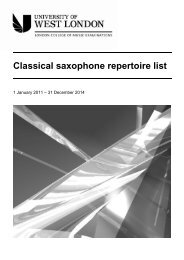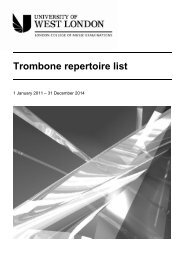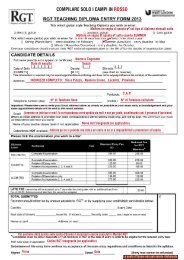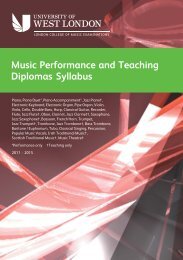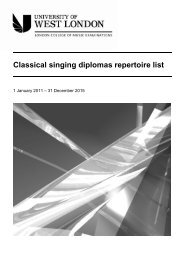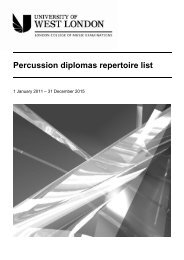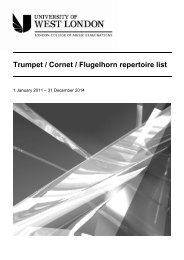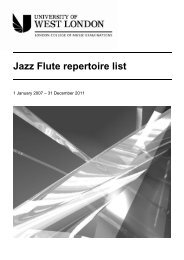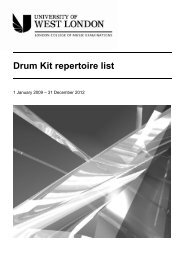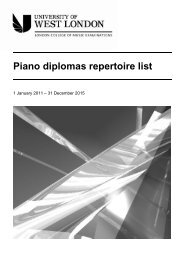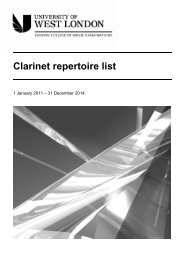LCM Exams - Jazz Piano Grades repertoire list - esamilcm.it
LCM Exams - Jazz Piano Grades repertoire list - esamilcm.it
LCM Exams - Jazz Piano Grades repertoire list - esamilcm.it
- No tags were found...
Create successful ePaper yourself
Turn your PDF publications into a flip-book with our unique Google optimized e-Paper software.
JAZZ PIANO2006-2011ContentsPage<strong>LCM</strong> Publications ................................................................. 3Grade 1 ................................................................................ 4Grade 2 ................................................................................ 5Grade 3 ................................................................................ 6Grade 4 ................................................................................ 7Grade 5 ................................................................................ 8Grade 6 ................................................................................ 9Grade 7 ................................................................................ 11Grade 8 ................................................................................ 13Musical Awareness .............................................................. 15Aural Tests .......................................................................... 17This <strong>repertoire</strong> <strong>list</strong> should be read in conjunction w<strong>it</strong>h the Syllabus for GradedExaminations in <strong>Jazz</strong> Performance. Copies are available free of charge from<strong>LCM</strong> Examinations (tel: 020 8231 2364) or from local representatives.Leisure Play examinations are also available, for candidates who wish to playpieces only. Please see Section 5 of the syllabus for details.This <strong>repertoire</strong> <strong>list</strong> is valid from 1 September 2006 until 31 December 2011.
<strong>LCM</strong> ExaminationsDirector of ExaminationsJohn Howard BA PhDChief Examiner in MusicPhilip Aldred BEd F<strong>LCM</strong>Univers<strong>it</strong>y of West London<strong>LCM</strong> ExaminationsSt Mary’s RoadEalingLondonW5 5RFtel: +44 (0)20 8231 2364fax: +44 (0)20 8231 2433email: lcm.exams@uwl.ac.ukuwl.ac.uk/lcmexams© Copyright 2011 by the Univers<strong>it</strong>y of West London, <strong>LCM</strong> Examinations2
<strong>LCM</strong> PublicationsThe following <strong>LCM</strong> Publications are relevant to this syllabus:• LL184 <strong>Jazz</strong> <strong>Piano</strong> Handbook 1 (<strong>Grades</strong> 1-5)• LL185 <strong>Jazz</strong> <strong>Piano</strong> Handbook 2 (<strong>Grades</strong> 6-8)• LL189 Specimen Aural Tests• LL205 <strong>LCM</strong> Aural Handbook<strong>LCM</strong> Publications are distributed by Music Exchange (tel: 0161 946 9301; email: mail@music-exchange.co.uk).A complete <strong>list</strong> of t<strong>it</strong>les may be found on their webs<strong>it</strong>e – www.music-exchange.co.uk3
JAZZ PIANO: GRADE TWOComponent 1 - Technical Work15 marksSCALES (legato, from memory) Minimum tempo: crotchet = 62D major – two octaves, hands together, straightD melodic OR harmonic minor (candidate’s choice) – two octaves, hands together, straightF major pentatonic and G major pentatonic – one octave, hands separately, swungD minor pentatonic and E minor pentatonic – one octave, hands separately, swungMODES (legato, from memory)Dorian starting on D and A – two octaves, hands together, straightARPEGGIOS (legato, from memory) Minimum tempo: crotchet = 56D major – two octaves, hands separately, straightG minor – two octaves, hands separately, straightEXERCISE (see <strong>Jazz</strong> <strong>Piano</strong> Handbook 1)All of the above can be found in <strong>Jazz</strong> <strong>Piano</strong> Handbook 1.Component 2 - Performance60 marksPerformance of THREE pieces from the following <strong>list</strong>. At least one piece must be taken from <strong>Jazz</strong> <strong>Piano</strong> Handbook 1.Ragalong <strong>Jazz</strong> <strong>Piano</strong> Handbook 1 (<strong>LCM</strong> Publications)Stroller <strong>Jazz</strong> <strong>Piano</strong> Handbook 1 (<strong>LCM</strong> Publications)Tut-Tuttin (No.19) Microjazz Collection No.1 (C Norton) (Boosey & Hawkes)Rag Time (No.21) Microjazz Collection No.1 (C Norton) (Boosey & Hawkes)Solace (S Joplin) Simply Classics (Alfred)Mellow Fellow Start <strong>Piano</strong> <strong>Jazz</strong> (M Cornick) (UE 17361)Time Passes Start <strong>Piano</strong> <strong>Jazz</strong> (M Cornick) (UE 17361)Lady Days (P Wedgwood) UpGrade <strong>Grades</strong> 1 & 2 (Faber)Homework Blues (P Wedgwood) UpGrade <strong>Grades</strong> 1 & 2 (Faber)Charleston (P Wedgwood) UpGrade <strong>Grades</strong> 1 & 2 (Faber)Autumn Leaves (J Kosma) What Else Can I Play Grade 2 (IMP)UFO Blues (J Parker) What <strong>Jazz</strong> and Blues Can I Play <strong>Grades</strong> 1, 2, 3 (IMP)Topsy What <strong>Jazz</strong> and Blues Can I Play <strong>Grades</strong> 1, 2, 3 (IMP)Chimes Blues (J Oliver) What <strong>Jazz</strong> and Blues Can I Play <strong>Grades</strong> 1, 2, 3 (IMP)Component 3 - Musical Awareness7 marksSee pages 15-16.Component 4 - Creative Response Test10 marksThe piece will consist of 4 bars in 4/4 time. The first two bars will be given and the candidate must improvise over bars3 and 4. See <strong>Jazz</strong> <strong>Piano</strong> Handbook 1 for examples. Approximately one minute will be allowed to study the test, duringwhich time the candidate may try the test if they wish.Component 5 - Aural Tests8 marksSee pages 17-21. Specimen tests can be found in <strong>Jazz</strong> <strong>Piano</strong> Handbook 1.5
JAZZ PIANO: GRADE FIVEComponent 1 - Technical Work15 marksSCALES (from memory, piano or forte) Minimum tempo: minim = 62F# major – two octaves, hands together, straight, legatoF and F# minors, melodic OR harmonic (candidate’s choice) – two octaves, hands together, straight, legatoG and F# Blues scales – one octave, hands together, swungMODES (legato, from memory)Dorian starting on F – two octaves, hands separately or together, straight or swungMixolydian starting on Bb – two octaves, hands separately or together, straight or swungAeolian starting on C – two octaves, hands separately or together, straight or swungLydian starting on Ab – two octaves, hands separately or together, straight or swungCHROMATIC SCALE (legato, from memory)Starting on any note – two octaves, hands together (similar motion), straightARPEGGIOS (legato, from memory) Minimum tempo: crotchet = 80C# and Bb majors – two octaves, hands together, straightB and F minors – two octaves, hands together, straightDOMINANT 7th BROKEN CHORDS (legato, from memory)D7, F7 and Bb7 – hands separately, resolving on the Tonic, swung (as illustrated in the Handbook)EXERCISE (see <strong>Jazz</strong> <strong>Piano</strong> Handbook 1)All of the above can be found in <strong>Jazz</strong> <strong>Piano</strong> Handbook 1.Component 2 - Performance60 marksPerformance of THREE pieces from the following <strong>list</strong>. At least one piece must be taken from <strong>Jazz</strong> <strong>Piano</strong> Handbook 1.Latin Carnival <strong>Jazz</strong> <strong>Piano</strong> Handbook 1 (<strong>LCM</strong> Publications)Sweet Blossom Rag <strong>Jazz</strong> <strong>Piano</strong> Handbook 1 (<strong>LCM</strong> Publications)Fiddlesticks Rag (A Coney) Complete <strong>Piano</strong> Player: Ragtime (K Baker) (Wise)Nocturne (M Cornick) <strong>Jazz</strong> After Hours (UE 21099)Ladybird (T Dameron) Joy of <strong>Jazz</strong> (Yorktown 21087)Maple Leaf Rag (S Joplin) Joy of <strong>Jazz</strong> (Yorktown 21087)No.96 (w<strong>it</strong>hout CD)Progressive Funk <strong>Piano</strong> Method (Gelling & Brown) (www.learntoplaymusic.com)Nos.93, 94 AND 95 (w<strong>it</strong>hout CD) Progressive Funk <strong>Piano</strong> Method (Gelling & Brown) (www.learntoplaymusic.com)Queen of Hearts (E Peters) Ragtime Preludes (Boosey & Hawkes)Twilight Boulevard (E Peters) Ragtime Preludes (Boosey & Hawkes)Summertime (G Gershwin) Take the Lead (<strong>Jazz</strong>) [w<strong>it</strong>h backing CD] (IMP)My Funny Valentine Take the Lead (<strong>Jazz</strong>) [w<strong>it</strong>h backing CD] (IMP)Guantanamera (D Fernandez) Take the Lead (Latin) [w<strong>it</strong>h backing CD] (IMP)La Isla Bon<strong>it</strong>a (M Ciccone) Take the Lead (Latin) [w<strong>it</strong>h backing CD] (IMP)Component 3 - Musical AwarenessSee pages 15-16.7 marksComponent 4 - Creative Response Test10 marksThe piece will consist of 8 bars. It will e<strong>it</strong>her be in 4/4 time or 3/4 time (jazz waltz). The first four bars will be given andthe candidate must improvise over bars 5 to 8. See <strong>Jazz</strong> <strong>Piano</strong> Handbook 1 for examples. Approximately one minutewill be allowed to study the test, during which time the candidate may try the test if they wish.Component 5 - Aural Tests8 marksSee pages 17-21. Specimen tests can be found in <strong>Jazz</strong> <strong>Piano</strong> Handbook 1.8
The candidate is required to produce a coherent response based on the opening bars. Keys will be up to three sharpsor flats. See <strong>Jazz</strong> <strong>Piano</strong> Handbook 2 for examples. Approximately one minute will be allowed to study the test, duringwhich time the candidate may try the test if they wish.Component 5 - Aural Tests8 marksSee pages 17-21. Specimen tests can be found in <strong>Jazz</strong> <strong>Piano</strong> Handbook 2.12
JAZZ PIANO: GRADE EIGHTTheory of Music Grade Five (or alternative) must have been passed; see Regulations.Component 1 - Technical WorkNo metronome markings are given; familiar<strong>it</strong>y and fluency are the prior<strong>it</strong>ies.All need to be prepared legato, piano and forte from memory; staccato is also required where indicated.Some scales are required straight or swung as indicated.SIMILAR MOTION SCALESThe candidate may choose to play the major and minor scales from one of the following groups:Group 1: C, C#, Bb, GGroup 2: D, Eb, F#, FGroup 3: E, A, B, Ab15 marksMajor keys - three octaves, hands separately or together, straight, legato or staccatoMinor keys, melodic OR harmonic (candidate’s choice) - three octaves, hands separately or together, straight, legatoor staccatoCHROMATIC SCALESW<strong>it</strong>h each hand separately in minor thirds, beginning on D and F – one octave, straight, legatoWHOLE TONE SCALESStarting on C and on C# – two octaves, hands separately or together, straight or swung, legatoDIMINISHED SCALESStarting on C – one octave, right hand only, starting on the half-step (C7b9) or the whole step (C°), straight or swung,as illustrated in <strong>Jazz</strong> <strong>Piano</strong> Handbook 2CHORDS AND VOICINGThe sus chord on any note, as illustrated in <strong>Jazz</strong> <strong>Piano</strong> Handbook 2All of the above can be found in <strong>Jazz</strong> <strong>Piano</strong> Handbook 2.Component 2 - Performance60 marksPerformance of THREE pieces from the following <strong>list</strong>. At least one piece must be taken from <strong>Jazz</strong> <strong>Piano</strong> Handbook 2.Autumn Leaves <strong>Jazz</strong> <strong>Piano</strong> Handbook 2 (<strong>LCM</strong> Publications)Cat & Mouse (Laura Rossi) <strong>Jazz</strong> <strong>Piano</strong> Handbook 2 (<strong>LCM</strong> Publications)Own compos<strong>it</strong>ion (based on Rhythm Changes)<strong>Jazz</strong> <strong>Piano</strong> Handbook 2(<strong>LCM</strong> Publications)A Taste of Honey (R Marlow/R Scott) <strong>Jazz</strong> <strong>Piano</strong> Handbook 2(<strong>LCM</strong> Publications)Peri’s Scope (Bill Evans) Bill Evans: <strong>Jazz</strong> <strong>Piano</strong> (Wise)The Midnight Sun Will Never Set (Q Jones)<strong>Jazz</strong> Club <strong>Piano</strong> Solos Vol.2 (arr. S Duro)(Wise)The Late Late Show (R Alfred/D Cavanagh)<strong>Jazz</strong> Club <strong>Piano</strong> Solos Vol.2 (arr. S Duro)(Wise)Black and Wh<strong>it</strong>e Rag (G Botsford) Ragtime (arr. K Baker) (Wise)Twelfth Street Rag (EL Bowman) Ragtime (arr. K Baker) (Wise)Rat Race Rag (M Haywood) Ragtime Today (Musonix)Birdland (J Zawinul) Take the Lead: <strong>Jazz</strong> (w<strong>it</strong>h backing CD) (IMP)I Wish The <strong>Jazz</strong> <strong>Piano</strong> Master (Grade 6+) (Faber)Around Midnight The <strong>Jazz</strong> <strong>Piano</strong> Master (Grade 6+) (Faber)Three <strong>Jazz</strong> Flavors (E Butterfield) The Joy of <strong>Jazz</strong> (Yorktown)Palm Gardens (Fats Waller) The Joy of <strong>Jazz</strong> (Yorktown)Blues Groove 2 / <strong>Jazz</strong> Groove 2 / R&B Groove 1 (A Gordon)The Art Of Successful Rhythm <strong>Piano</strong>/Keyboard Playing (ADG Productions)[To be played as rhythm section w<strong>it</strong>h CD. See p1 of book]Wr<strong>it</strong>ten charts may be developed and embellished contextually and creatively.Improvised elements must not be wr<strong>it</strong>ten out.13
Component 3 - Musical AwarenessSee pages 15-16.7 marksComponent 4 - Creative Response Test10 marksA short passage in e<strong>it</strong>her 3/4 (<strong>Jazz</strong> Waltz) or 4/4 time will be given, using chord structures, scales and modes coveredin <strong>Grades</strong> 1-8. The opening bars will be given, then chords will be indicated. The candidate is required to produce acoherent response based on the opening bars. Keys will be up to four sharps or flats. See <strong>Jazz</strong> <strong>Piano</strong> Handbook 2 forexamples. Approximately one minute will be allowed to study the test, during which time the candidate may try thetest if they wish.Component 5 - Aural TestsSee pages 17-21. Specimen tests can be found in <strong>Jazz</strong> <strong>Piano</strong> Handbook 2.8 marks14
Musical AwarenessNotes:1. All questions and answers are verbal. Candidates are not expected to demonstrate on their instrument or tosing; but they may choose to do so if they feel that this would clarify their answer. Responses to questionsrelated to the Handbook Exercises may include clapping / tapping.3. There is no set form of words, or number of questions. Examiners are encouraged to conduct the tests in aflexible and conversational manner. The number of questions asked, and the content of the questions, may differfrom candidate to candidate. However, the prime focus will always be the music performed in the Performancesection of the exam, together w<strong>it</strong>h the Handbook Exercise .4. The knowledge required is cumulative for <strong>Grades</strong> 1-8; ie. any knowledge required in earlier grades is requiredfor later grades. However, in the case of the Handbook Exercises, examiners will refer only to the exercise setfor the particular grade.5. Although accuracy and appropriateness of response are the principal cr<strong>it</strong>eria of assessment, examiners will alsolook for articulacy, use of correct terminology, and a sense of engagement w<strong>it</strong>h, and understanding of, the musicperformed.Requirements:GRADES 1 AND 2Candidates should be able to:• name, and explain the meaning of, all basic notational elements in the music performed in the Performancecomponent of the exam, including: staff, bars and bar-lines, clefs, p<strong>it</strong>ches of individual notes, rhythmic valuesof notes and rests (including dotted notes), key and time signatures, accidentals, dynamics, articulationmarkings, phrases, ornaments, and any add<strong>it</strong>ional markings;• explain which is their favour<strong>it</strong>e piece and why;• assign simple descriptive words to pieces to describe their mood ('happy', 'sad', 'bouncy', 'jazzy', 'gentle', etc.);• respond to questions relating to the Grade 1 or 2 Rhythm and Improvisation Exercise in the <strong>Jazz</strong> or <strong>Jazz</strong><strong>Piano</strong> Handbook 1.GRADE 3In add<strong>it</strong>ion to the requirements for <strong>Grades</strong> 1 and 2, candidates may be asked to:• identify intervals up to and including a fifth by numerical value only (eg. 'second', 'fourth', etc.);• demonstrate an understanding of basic chord symbols;• describe the mood or character of pieces using appropriate descriptive terminology ('fast and lively', 'gentleand flowing', 'like a dance', etc.);• identify contrasts of mood w<strong>it</strong>hin pieces;• discuss any pictorial or descriptive element of the music;• respond to questions relating to the Grade 3 Rhythm and Improvisation Exercise in the <strong>Jazz</strong> or <strong>Jazz</strong> <strong>Piano</strong>Handbook 1.GRADE 4In add<strong>it</strong>ion to the requirements for <strong>Grades</strong> 1-3, candidates may be asked to:• identify intervals up to and including an octave by numerical value only (eg. 'fourth', 'seventh', etc.);• demonstrate basic knowledge of composers and/or famous performers of the music performed, including theirnational<strong>it</strong>y and approximate dates;• discuss their approaches to learning the pieces, and to identify any particular difficulties (musical or technical)which were encountered;• respond to questions relating to the Grade 4 Rhythm and Improvisation Exercise in the <strong>Jazz</strong> or <strong>Jazz</strong> <strong>Piano</strong>Handbook 1.15
GRADE 2RhythmA short harmonised passage, of approximately 8 bars in length, will be played. The passage will be in e<strong>it</strong>her3/4 or 4/4 time. Candidates will be asked to:1 (a) identify the time signature as "3" or "4" time (1 mark).1 (b) beat (conduct) time, w<strong>it</strong>h a clear beat-shape (conducting pattern), in time w<strong>it</strong>h the examiner’s playing, as theexaminer plays the passage again (1 mark).The examiner will select one bar from the passage, and will play <strong>it</strong> in an unharmonised version. Candidateswill be asked to:1 (c) identify and describe the note values (rhythmic values of the notes) in the bar (2 marks).P<strong>it</strong>chA major or minor triad will be played, followed by one note taken from the triad. Candidates will be asked to:2 (a) identify the note as “bottom, middle or top” OR “Doh, Mi or Soh” OR “root, 3rd or 5th” (candidate's choice) (1mark).The triad will be played again. Candidates will be asked to:2 (b) state if the triad is major or minor (1 mark).The key-chord of a major key (C, F, G, and D majors only) will be played, and the key stated, followed by thefirst five notes of the scale in ascending order. The examiner will then play any ONE of these notes again.Candidates will be asked to:2 (c) identify the note, EITHER by letter name OR by tonic sol-fa name OR by number (1, 2, 3, 4 or 5) as electedby the candidate (1 mark).The test will be repeated, using a different example (1 mark).GRADE 3RhythmA short harmonised passage, of approximately 8 bars in length, will be played. The passage will be in 6/8time. Candidates will be asked to:1 (a) beat (conduct) time, w<strong>it</strong>h a clear beat-shape (conducting pattern), 2 beats in the bar (NOT 6 beats in the bar),in time w<strong>it</strong>h the examiner’s playing, as the examiner plays the passage again (1 mark).The candidate will be shown three lines of music (marked 1, 2 and 3), each of which will contain fourindividual bars of music in 6/8 time (marked a, b, c and d). The examiner will indicate which line of music isbeing used. One of the bars on that line will be played, twice. Candidates will be asked to:1 (b) indicate which bar (a, b, c or d) has been played (1 mark).The test will be repeated, using a different example (1 mark).P<strong>it</strong>chAn interval will be played twice, once w<strong>it</strong>h the p<strong>it</strong>ches sounded successively, and once w<strong>it</strong>h the p<strong>it</strong>chessounded together. The intervals will be restricted to the following: Major 2nd, Major 3rd, Perfect 4th, Perfect5th. Candidates will be asked to:2(a) identify the interval, by numerical value only (2nd, 3rd, 4th, 5th) (1 mark).The test will be repeated, using a different interval (1 mark).The key-chord of a major or minor key (C, G, D, F and Bb majors; A and E minors only) will be played, andthe key stated. A short unharmonised melody, in the same key, of approximately 3 bars in length, will beplayed, twice. Rhythms will be lim<strong>it</strong>ed to crotchets, quavers, minims, dotted minims and semibreves.Candidates will be asked to:2 (b) sing back the melody (3 marks).Candidates may elect to respond to test 2(b) by playing the melody on their instrument, instead of singing. Inthis case, the examiner should be informed in advance of the tests being administered (see note 1 above).18
GRADE 4RhythmA short harmonised passage, of approximately 8 bars in length, will be played. The passage will be ine<strong>it</strong>her 2/4, 3/4, 4/4 or 6/8 time. Candidates will be asked to:1 (a) beat (conduct) time, w<strong>it</strong>h a correct and clear beat shape (conducting pattern) according to the time signatureof the music, in time w<strong>it</strong>h the examiner's playing, as the examiner plays the passage again. (Passages in 6/8time should be conducted w<strong>it</strong>h a 2-beat pattern). (2 marks).A short phrase, of approximately 2 bars in length, taken from the passage, will be played in an unharmonisedversion, twice. The phrase will include no rhythmic values shorter than a semiquaver, but may include simpledotted patterns. Candidates will be asked to:1 (b) clap or tap back the rhythm of the phrase (2 marks).P<strong>it</strong>chAn interval will be played twice, once w<strong>it</strong>h the p<strong>it</strong>ches sounded successively, and once w<strong>it</strong>h the p<strong>it</strong>chessounded together. The interval will be restricted to any major, minor or perfect interval up to and including anoctave. Candidates will be asked to:2(a) identify the interval, by numerical value and type (1 mark).The test will be repeated, using a different interval (1 mark).The candidate will be shown three similar versions of a short melody (marked 1, 2 and 3). The versions willdiffer in p<strong>it</strong>ch, but not in rhythm. One of the versions will be played, twice. Candidates will be asked to:2 (b) identify which version was played (2 marks).GRADE 5RhythmA short harmonised passage, of approximately 8 bars in length, will be played. Thepassage will be in e<strong>it</strong>her 2/4, 3/4, 4/4, 6/8 or 6/4 time. Candidates will be asked to:1 (a) beat (conduct) time, w<strong>it</strong>h a correct and clear beat shape (conducting pattern) according to the time signatureof the music, in time w<strong>it</strong>h the examiner's playing, as the examiner plays the passage again. (Passages in 6/8or 6/4 time should be conducted w<strong>it</strong>h a 2-beat or 6-beat pattern as appropriate). (2 marks).A short phrase, of approximately 2 bars in length, taken from the passage, will be played in an unharmonisedversion, twice. Candidates will be asked to:1 (b) identify and describe the note values (rhythmic values of the notes) in the phrase (2 marks).P<strong>it</strong>chAn interval will be played twice, w<strong>it</strong>h the p<strong>it</strong>ches sounded together. The interval may be any major, minor orperfect interval w<strong>it</strong>hin the octave, as well as the augmented 4th / diminished 5th. Candidates will be asked to:2(a) identify the interval, by type and numerical value (1 mark).The test will be repeated, using a different interval (1 mark).The key-chord of a major key will be sounded. A short melody in the same key, of approximately 2 bars inlength, will be played, finishing w<strong>it</strong>h a harmonised cadence (perfect, imperfect, plagal, or interrupted) in thehome key. Candidates will be asked to:2 (b) identify the cadence, e<strong>it</strong>her by <strong>it</strong>s conventional name, or as “finished” (perfect and plagal) or “unfinished”(imperfect or interrupted) (1 mark).The test will be repeated, using a different example (1 mark).19
GRADE 61(a)1(b)1(c)1(d)1(e)Rhythm and P<strong>it</strong>chA harmonised passage, in simple time, of not more than six bars in length, and containing some syncopatedpatterns, will be played, twice. Candidates will be asked to:identify the time signature (1 mark).identify whether the passage is in a major or minor key (1 mark).identify, by number and type, any interval w<strong>it</strong>hin the octave, occurring in the melody-line between twosucceeding notes. These p<strong>it</strong>ches will be played again, first as occurring in the melody, and then w<strong>it</strong>h thep<strong>it</strong>ches sounded together (1 mark).A short phrase from the passage, of 1-2 bars in length, will be played again in an unharmonised version.Candidates will be asked to:clap or tap back the rhythm of the phrase (1 mark).identify and describe the note values (rhythmic values) in the phrase (2 marks).P<strong>it</strong>chThe key-chord of a major key will be sounded. A short melody in the same key, of approximately 2 bars inlength, will be played, finishing w<strong>it</strong>h a harmonised cadence (perfect, imperfect, or interrupted) in the homekey. Candidates will be asked to:2 (a) identify the cadence by <strong>it</strong>s conventional name (1 mark).The key-chord of a major key will be sounded, and the key named. A short harmonised passage in the samekey, of approximately 4 bars in length, will be played. The passage will contain one modulation to a relatedkey (dominant, subdominant, or relative minor), finishing w<strong>it</strong>h a perfect cadence in that key. Candidates willbe asked to:2 (b) identify the key into which the passage has modulated, e<strong>it</strong>her by name or byrelationship to the home key (candidate's choice) (1 mark).GRADE 71 (a) A harmonised passage of approximately 12 to 16 bars in length, in e<strong>it</strong>her simple or compound time, will beplayed, once. Candidates will be asked a selection of the following:• to identify the time signature• to identify whether the passage is in a major or minor key• to describe the overall dynamics• to describe the basic overall form (this will be lim<strong>it</strong>ed to AB, ABA, AAB, ABAB, AABA) (2 marks).1 (b) The candidate will be given a copy of the score, w<strong>it</strong>hout phrasing, tempo, articulation, or dynamic markings.The passage will be played once again in full; further shorter sections may also be played again. Candidateswill be asked a selection of the following:• to suggest an appropriate tempo marking• to describe changes in tempo• to name the key• to describe phrasing patterns• to describe dynamics• to describe articulation• to identify modulations• to identify ornaments• to confirm their description of the form (4 marks).2. The key-chord of a major or minor key will be sounded. A short harmonised passage in the same key, ofapproximately 2 bars in length, will be played, finishing w<strong>it</strong>h a harmonised cadence (perfect, imperfect, plagal,or interrupted) in the home key. Candidates will be asked to:identify the cadence by <strong>it</strong>s conventional name. (1 mark).The test will be repeated, using a different example (1 mark).20
GRADE 81. A harmonised passage of approximately 12 to 16 bars in length, in e<strong>it</strong>her simple or compound time, will beplayed, once. Candidates will be asked a selection of the following:• to identify the time signature;• to identify whether the passage is in a major or minor key;• to suggest an appropriate tempo marking;• to describe and identify any particularly noticeable aspects of the dynamics, phrasing, articulation,modulation, ornamentation, texture, etc. (examiners may play certain extracts from the passage again);• to suggest a musical style (Renaissance, Baroque, Classical, Romantic, Twentieth Century or Modern,<strong>Jazz</strong> / Popular);• to identify any interval in the melodic line between two successive notes, up to and including a Major 10th(the two p<strong>it</strong>ches will be played again, as occurring in the melody);• to clap back, or identify and describe the note values (rhythmic values) of, a short phrase of 1-2 bars induration, taken from the passage and played again in an unharmonised version;• to identify a cadence, taken from the passage, played again by the examiner (4 marks).2. The candidate will be given a copy of the score, w<strong>it</strong>hout phrasing, tempo, articulation, or dynamic markings.The passage will be played once again in full; further shorter sections, of up to 4 bars in length, may also beplayed again, sometimes w<strong>it</strong>h changes in phrasing, tempo, articulation and/or dynamics. Candidates will beasked a selection of the following:• to name the key• to identify modulations• to identify ornaments• to describe the overall form (in add<strong>it</strong>ion to those specified for Grade 7, these may include ABCA, ABCBA,AA'BA, ABA'B, and similar structures, as well as more organic forms, or forms based on im<strong>it</strong>ative or fugalstructures);• to identify simple melodic, rhythmic or harmonic devices, such as sequence, inversion, repet<strong>it</strong>ion, pedalpoints, augmentation / diminution, motivic development, etc.• to identify changes in phrasing, tempo, articulation and/or dynamics, in short passages, of up to 2 bars inlength, played in two different styles by the examiner (4 marks).June 201121



